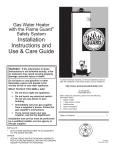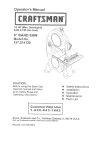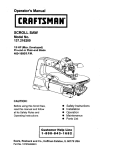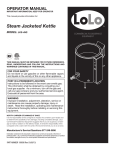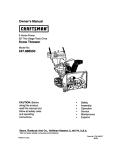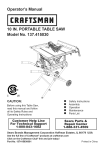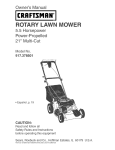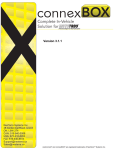Download Craftsman 137.214090 Operator`s manual
Transcript
Operator's Manual CRRFTSMFIH 113 HP (Max. Developed) 2480 F.P.M. (No load) / 9" BAND SAW Model No. 137.214090 / / / CAUTION: Before using this Band Saw, read this manual and follow all its Safety Rules and Operating Instructions 1-800-843-1682 I Customer Help Sears, Roebuck and Co., Hoffman Safety Instructions Installation Operation Maintenance Parts List • Espafiol Line Estates, Visit our Craftsman website: www.sears.com/craftsman Part No. 13721409001 • • • • • I IL 60179_ SECTION Warranty ...................................................................................................................................... Products Specifications ................................................................................................................ Safety Instructions ....................................................................................................................... Accessories and Attachments ........................................................................................................ Carton Contents .......................................................................................................................... Know Your Band Saw ................................................................................................................... Glossary of Terms ........................................................................................................................ Assembly and Adjustments ........................................................................................................... Operation .................................................................................................................................... Maintenance ................................................................................................................................. Troubleshooting Guide .................................................................................................................. Parts ........................................................................................................................................... Espahol ........................................................................................................................................ PAGE 2 2 3 6 6 7 8 9 15 17 18 20 22 FULL ONE YEAR WARRANTY If this Band Saw fails clue to a defect in material or workmanship Bears will at its option repair or replace it free of charge. within one year of date of purchase, Return this Band Saw to a Sears Service Center for repair, or to place of purchase This warranty to state. gives you specific for replacement. legal rights, and you may also have other rights that may vary from state Sears, Roebuck and Co., Dept. 817 WA, Hoffman Estates, IL 60179 Some dust created by power sanding, sawing, grinding, drilling and other construction activities contains chemicals known to the state of California, to cause cancer, birth defects or other reproductive harm. Some examples of these chemicals are: Lead from lead-based paints Crystalline silica from bricks, cement and other masonry products • Arsenic and chromium from chemically treated lumber Your risk from these exposures varies, depending on how often you do this type of work. To reduce your exposure to these chemicals, work in a well-ventilated area and work with approved safety equipment such as dust masks that are specially designed to filter out microscopic particles. Motor Power source ......... 120 V, 60 Hz, 2.5Amp., Ac Speed ...................... 2480FPM (No load) Speed control .......... Electronic Horsepower ............ 1/3HP(Max. Developed) Cutting Capacity Throat .................. 9" Height .................. 3-1/2" Blade Width .................... t/8" to 3/8 _ Length .................. 59" to 59-1/_." Table Size .................... 12-1/4" x 11-1/:_' Tilt ...................... 0° - 3° Left; O° - 45 ° Right Table Extension ............ Yes, with fence Extension fence Capacity. 12" Right Sawdust blower ........................... Net weight .................................. Yes 30.8 Ibs. To avoid electrical hazards, fire hazards, or damage to the tool, use proper circuit protection. Use a separate electrical circuit for your tools. This Band Saw is wired at the factory for 120V operation. Connect to a 120V, 15 AMP branch circuit and use a 15 Amp time delay fuse or circuit breaker. To avoid shock or fire, replace power cord immediately if it is worn, cut or damaged in any way. GENERAL BEFORE SAFETY 12.ALWAYS WEAR EYE PROTECTION. Any Band Saw can throw foreign objects into the eyes that could cause permanent eye damage. ALWAYS wear Safety Goggles (not glasses) that comply with ANSI Safety standard Z87.1 Everyday eyeglasses have only impact-resistance lenses. They ARE NOT safety glasses. Safety Goggles are available at Sears. NOTE: Glasses or goggles not in compliance with ANSI Z87,1 could cause serious injury. INSTRUCTIONS USING THE BAND SAW Safety is a combination of common sense, staying alert and knowing bow to use this Band Saw. To avoid mistakes that could cause serious injury,de not plug the Band Saw in until you have read and understood the following: 13.WEAR A FACE MASK OR DUST MASK. Sawing operation produces dust. 1. READ and become familiar with the entire Operator's Manual. LEARN the tool's application, limitations and possible hazards, 14.SECURE WORK. Use clamps or a vise to hold work when practical. It's safer than usingyour hand and it frees both hands to operate tool. 2. KEEP GUARDS IN PLACE and in workingorder. 15.DISCONNECT TOOLS before servicing;when changing accessories such as blades, bits, cutters, and the like. 3, REMOVE ADJUSTING KEYS AND WRENCHES. Form the habit of checking to see that keys and adjusting wrenches are removed from the tool before turning ON. 16.REDUCE THE RISK OF UNINTENTIONAL STARTING. Make sure switch is in OFF position before plugging in. 4. KEEP WORK AREA CLEAN. Cluttered areas and benches invite accidents. 17.USE RECOMMENDED ACCESSORIES. Consult the Operator's Manual for recommended accessories. The use of improper accessories may cause serious iniury. 5. DON'T USE IN DANGEROUS ENVIRONMENT. Don't use power tools in damp or wet locations, or expose them to rain, Keep work area well lighted. 18.NEVER STAND ON TOOL. Serious injury could occur if the tool is tipped or if the cutting tool is unintentionallycontacted. 6. KEEP CHILDREN AWAY.All visitors should be kept a safe distance from work area. 7. MAKE WORKSHOP CHILD PROOF with padlocks, master switches, or by removing starter keys. 19.CHECK FOR DAMAGED PARTS. Before further use of the tool, a guard or other part that is damaged should be carefully checked to determine that it will operate properly and perform its intended function check for alignment of moving parts, binding of moving parfs, breakage of parts, mounting, and any other conditionsthat may affect its operation. A guard or other part that is damaged should be properly repaired or replaced. 8. DON'T FORCE THE TOOL. It will do the job better and safer at the rate for which it was designed. 9. USE THE RIGHT TOOL. Do not force tool or attachment to do a)ob for which it was not designed. 10.USE PROPER EXTENSION CORD. Make sure your extension cord is in good condition. When using an extension cord, be sure to use one heavy enough to carp/the current your product wilt drew. An undersized cord will result in a drop in line voltage and in loss of power that will cause the tool to overheat. The table on page 5 shows the correct size to use depending on cord length and nameplate ampere rating, tf in doubt, use the next heavier gauge. The smaller the gauge number, the heavier the cord. 20.NEVER LEAVE TOOL RUNNING UNATTENDED. TURN POWER "OFF". Don't leave tool until it comes to a complete stop. 21 .DON'T OVERREACH. Keep proper footing and balance at all times. 22.MAINTAIN TOOLS WITH CARE. Keep tools sharp and clean for best and safest performance. Follow instructionsfor lubricating and changing accessories. 11 .WEAR PROPER APPAREL, Do not wear loose clothing,gloves, neckties, rings, bracelets, or other jewelry that may get caught in moving pads. Non-slip footwear is recommended. Wear protective hair covering to contain long hair. i 23.DO NOT use power tools in the presence of flammable liquidsor gases. 3 24.DO NOT OPERATE the tool if you are under the influence of any drugs,alcohol or medication that could affect your ability to use the tool propedy. 12. SMALL PIECES should be secured with jigs or fixtures. Do not hand hold pieces that are so small your fingers are under the blade guard. 25.ALWAYS operate the band saw in a well-ventilated area and provide for proper dust removal. Use dust collection systems whenever possible. Dust generated from certain materials can be hazardous to your health, 13. SUPPORT round work properly (with a V-block or clamped to the miter gauge) to prevent it from rolling and the blade from biting. SPECIFIC SAFETY INSTRUCTIONS BAND SAWS FOR TO AVOID INJURY from unexpected movement, make sure the saw is on a firm, level surface, propedy secured to prevent rocking. Make sure there is adequate space for operating. Bolt the saw to a support surface to prevent slipping, walking, or sliding during operation. 2. 14. CUT only one workpiece at a time. Make sure the table is clear of everything except the workpiece and itsguides before you turn the saw on. TURN the saw OFF and unplug the saw before moving it. 15. ALWAYS WATCH the saw run before each use. If there is excessive vibration or unusual noise, stop immediately. Turn the saw OFF. Unplug it immediately. Do not startthe saw again untilthe problem has been located and corrected. 16. TO FREE any jammed material, turn the switch OFF. Remove the switch key and unplug the saw. Wait for all moving parts to stop before removing jammed material. 3. USE THE CORRECT size and style of blade. 4. USE blades rated at 2480 FPM or greater. 17. DON'T LEAVE the work area until all moving parts are stopped. To child-proof the workshop, shut OFF the power to master switches and remove the switch key from the band saw. Store it in a safe place, away from children. 5. MAKE SURE the blade teeth point down and towards the table. t?lir=rl_,_=] Ol[_[e 6. BLADE GUIDES, SUPPORT BEARINGS, AND BLADE TENSION must be properly adjusted to avoid accidental blade contact and to minimize blade breakage. To maximize blade support, always adjust the upper blade guide and blade guard so that it is 1/8 inch above the workpiece. 7. TABLE LOCK HANDLE should be tight. 8. USE EXTRA CAUTION with large, very small or awkward workpieces. 9. USE EXTRA SUPPORTS to prevent workpieces from sliding off the table top. Never use another person to support the workpiece. 10. WORKPIECES must be secured so they don't twist, rock, or slip while being cut. For your own safety, read the entire instructionmanual before operating the band saw. 1. Wear eye protection. 2. Do not wear gloves, necktie, or loose clothing. 3. Make sure the saw is on a firm level surface and properly secured. 4. USE ONLY THE RECOMMENDED ACCESSORIES. 5. Use extra caution with very large, very small, or awkward workpieces. 6. Keep hands away from the blade at all times to prevent accidental injury. 7. Do not remove jammed cutoff pieces until the blade has stopped. 8. Maintain proper adjustment of blade tension, blade guides and thrust bearings. 9. Adjust upper guide to just clear the workpiece. 10. Hold the workpiece firmly against the table. 11. PLAN intricate and small work carefully to avoid pinching the blade. Avoid awkward operation and hand positions to prevent accidental contact with the blade. _ 4 _ ql ELECTRICAL REQUIREMENTS GROUNDING INSTRUCTIONS IN THE EVENT OF A MALFUNCTION OR BREAKDOWN, grounding provides a path of least resistance for electric current and reduces the risk of electric shock. This tool is equipped with an electric cord that has an equipment-grounding conductor and a grounding plug. The plug MUST be plugged into a matching receptacle that is properly installed and grounded in accordance with ALL local codes and ordinances, DO NOT MODIFY THE PLUG PROVIDED. If it will not fit the receptacle, have the proper receptacle installed by a qualified electrician. IMPROPER CONNECTION of the equipment-grounding conductor can result in risk of electric shock. The conductor with green insulation (with or without yellow stripes) is the equipment-grounding conductor. If repair or replacement of the electric cord or plug is necessary, DO NOT connect the equipment-grounding conductor to a live terminal. as the current stamped on the motor nameplate. Running at a lower voltage will damage the motor. This tool is intended for use on a circuit that has a receptacle like the one illustrated in Figure A. Figure A shows a 3-prong electrical plug and receptacle that has a grounding conductor. If a properly grounded receptacle is not available, an adapter (Figure B) can be used to temporarily connect this plug to a 2-contact grounded receptacle. The temporary adapter should be used only until a properly grounded receptacle can be installed by a qualified technician. The adapter (Figure B) has a rigid lug extending from it that MUST be connected to a permanent earth ground, such as a properly grounded receptacle box. The Canadian Electrical Code prohibits the use of the adapters. CAUTION: In all cases, make certain the receptacle is properly grounded. If you are not sure, have a qualified electrician check the receptacle. This tool is for indoor use only. Do not expose to rain or use in damp locations. CHECK with a qualified electrician or service person if you do not completely understand the grounding instructions,or if you are not sure the tool is properly grounded. 3-Preng Plug Fig. A g Prong USE ONLY 3-WIRE EXTENSION CORDS THAT HAVE 3-PRONG GROUNDING PLUGS AND 3-POLE RECEPTACLES THAT ACCEPT THE TOOL'S PLUG. REPAIR OR REPLACE DAMAGED OR WORN CORD IMMEDIATELY. GUIDELINES FOR EXTENSION Fig. B CORDS USE PROPER EXTENSION CORD. Make sure your extension cord is in good condition.When using an extension cord, be sure to use one heavy enough to carry the current your productwill draw. An undersized cord will cause a drop in line voltage, resulting in loss of power and cause overheating. The table below shows the correct size to usa depending on cord length and nameplate ampere rating. If in doubt, use the next heavier gauge. The smaller the gauge number, the heavier the cord. Be sure your extension cord is properly wired and in good condition. Always replace a damaged extension cord or have it repaired by a qualified person before using it. Protect your extensioncords from sharp objects, excessive heat and damp or wet areas. Use a separate electrical circuit for your tools. This circuit must not be less than # 12 wire and shouldbe protected with a t 5 Amp time delay fuse. Before connecting the motor to the power line, make sure the switch is in the OFF position and the electric current is rated the same _5 Properly Grounded 3-Prong Receptacle Grounding Lug I _(_n__ _'_/ F(_ _ _ I _._L _."_. _ Adapter _-_3'=_1"__ ,///.:o_ Make Sure This rl is Connected to a _ Known Ground I]_" 2-Prong Receptacle rRl_1 d='q]_[i This tool must be grounded while in use to protect the operator from electrical shock. _lllb?lhWJllJlVlK_==lED_s--__l-- = ;;_:all=l_l_[o]_.|lKil|.-lls¢.a _yirJ[; (When using 120 volts only) Ampere Morethan To_llengthofcordin Rating notmore tt_an 25' 50' feet 100' 150' 0 6 18 16 16 14 12 6 10 18 16 14 10 12 12 16 16 J14 16 12 14 12 notrecommended RECOMMENDED UNPACKING AND CHECKING ACCESSORIES CONTENTS Carefully unpack the band saw and all its parts, and compare against the illustration following. Place the saw on a secure surface and examine it carefully. To avoid injury: Use only accessories recommended for this band saw. Follow instructions that accompany accessories. Use of improper accessories may cause hazards. Use only accessories designed for thisband saw to avoid injury from thrown broken parts or workpieces. Do not use any accessory unless you have completely read the instruction or operator's manual for that accessory. To avoid injuryfrom unexpected starting, do not plug the power cord into a power source receptacle during unpacking and assembly. This cord must remain unplugged whenever you are assembling or adjusting the saw. Although compact, this saw is heavy. To avoid back injury, get help whenever you have to lift the saw. If any part is missing or damaged, do not plug the band saw in until the missing or damaged part is replaced, and assembly is complete. Visit your Sears Hardware Department or see the Sears Power and Hand Tool Catalog for the following accessories: ITEM Miter gauge Blade width: 1/8" to 3/8" Blade length: 59" to 59-1/4," _le ! Assembly 2 Bolt Hex. Wrench Miter /_ Band Saw Assembly Gauge Hex. Nut Spring Washer j- 6 Blade guard ,_ _ Upper blade _ support bearing Upper blade guide Upper switchON/OFF blade, wheel Blade S Wheel brush J / Lower blade wheel Blade tension knob Upper guide lock knob Blade tension knob Extension Fence Sawdust blower Table Extension Table insert Miter storage Work table Motor cord Motor Base Mounting holes 7 _ f BAND SAW TERMS KERF -- The matedal removed by the blade in a through cut, or the slot produced by the blade in a non-through or partial cut. BLADE GUIDES -- Support the blade and keep it from twisting during operation. Blade guides must be adjusted when blade is changed or replaced. LEADING EDGE -- The front edge of the workpiece pushed into the cutting tool first. UPPER GUIDE LOCK KNOB -- locks the upper slide. Use it after adjusting the upper guide assembly to make sure upper blade guide just clears workpiece before cutting. Upper guide lock knob must be tightened before the band saw is turned on. MITER CUT -- An angle cut made across the width of a workpiece. RESAW -- A cutting operation to reduce the thickness of the workpiece to make thinner workpiece. TABLE LOCK KNOB -- locks the table in place, RESIN -- A sticky sap that has hardened. TILT (BEVEL) SCALE -- shows the degree the table is tilted for bevel cutting. RIPPING CUT -- A cutting operation along the length of the workpiece. BLADE TENSION KNOB -- controls the amount of blade tension when changing blades. R.P.M. -- Revolutions per minute. The number of turns completed by a spinning object in one minute. BLADE TRACKING KNOB -- adjusts blade position so blade always runs in the center of the wheel. SAW BLADE PATH -- The area of the workpiece or table top directly in line with the travel of the blade or the part of the workpiece that will be.cut. SAWDUST PORT -- helps keep the machine free from sawdust, The sawdust port makes an excellent hook-up for a wet/dry vacuum. SET -- The distance between two saw blade teeth tips, that are bent outward in opposite directions to each other. The further apart the tips are, the greater the set. ON/OFF SWITCH -- has a built-in child safety lock. To lock the switch in the OFF position, remove the switch key from the switch. WOODWORKING TRAILING EDGE -- The workpiece edge last cut by the blade. TERMS WORKPIECE -- The item being cut. The surfaces of a workpiece are commonly referred to as faces, ends and edges. BEVEL CUT -- An angle cut made through the face of a workpiece. COMPOUND cut. CUT -- A simultaneous WORKTABLE -- The surface on which the workpiece rests while performing a cutting or sanding operation. bevel and miter CROSSCUT -- A cut made across the width of the workpiece. Leadin F.P.M. -- Feet per minute. Used in reference to the surface speed of the saw blade. Sawlo_de Surface FREE HAND -- Performing a cut without using a fence (guide), hold-down or other proper device to prevent the workpiece from twisting during the cut'ling operation. GUM -- A sticky sap-based HEEL -- Misalignment Path Kerr residue from wood products. Trailing Edge of the blade. 8 ASSEMBLY TOOLS INSTRUCTIONS NEEDED Fig. B ! ',I:',',Ii IIIII:IZ I' Phillips screwdriver Adjustablewrench Combinationsquare Straight edge r_w_ =W1F_G For your safety, never connect plug to power source receptacle until all assembly and adjustment steps are completed, and you have read and understood the safety and operating instructions. SAWDUST COLLECTION PORT (FIG. C) This band saw will accept a hose or vacuum accessory (not provided) to be connected to the port (1) on the right side of base. It excessive sawdust buildup occurs inside the base, use a wet/dry vacuum cleaner or manually remove sawdust by removing the screws on the dgbt side of saw. Reattach the metal plate and screws before starting the saw. This will keep your saw cutting efficiently. Fig. C ASSEMBLY THE TABLE (FIG. D) 1. Remove the table aligning screw (1) from the table (2). 2. Guide the table slot (3) over the saw blade and rotate a 1/4 turn, so the slot is perpendicular to the flat side of the blade. 3. Insert three bolts (4) through the table holes, place spring washers (5) and hex nuts (6) on the bolts. Do not tighten. 4. Align the 0° mark on the scale to the pointer on the support bracket. 5. Place the table aligning screw (1) in the front of the table, in the slot (3), and tighten. Fig. D 4 2-- t MITERGAUGESTORAGE (FIG.B} The right rear side of the body (t) has a slot (2) designed to store the miter gauge (3). 3 _ii!ili!!i_iiii!_iii_ili_i_i_ii!_ _i_!i_i!_i;!iiii_iiii!_i!_i_i!!!!!!i!i!i!ji!!!!ii?!!_!i!ii!i_!!!i?!iiii_!_! _!_!II_!I_!II!I -_! g !!_?_iii_i_!i_i!i_ii_ili;F!_!_!!i_ii!i!_!!_i!!!!_ii_ii_i!_!_ ii!_Fi_iiii:iiiil INSTALLING AND REMOVING BLADES (FIG E) Fig. E To avoid injury from accidental starting, always turn the switch OFF and remove power cord plug from power source before removing or replacing the blade. 2 Removing 1. Loosen the blade tension by turning the blade tension knob (1) counterclockwise. 2. Remove the table aligning screw (2) from the table. 3. Open the wheel cover. 4. Loosen the two blade guard mountingscrews and remove the blade guide (8). 8. Carefully pull the blade from the side slot (6) and from the wheels (7), 6. Swing the left side of the blade toward you, turning the blade so it will fit through the slot (8) in the table, and remove. Installing 1. Make sure the blade tension knob (1) is turned counterclockwise until it stops. 2. Remove the table aligning screw (2) from the table. 3. Open the wheel cover. 4. Guide the new blade (4) through the table slot (8), making sure the blade teeth are pointing forward and down. NOTE: To avoid lifting the workpiece, the blade teeth must point downward toward the table. 5. Swinging the left side away and back, place the blade on the upper and lower wheels (7). 6. Place the blade carefully between the upper and lower blade guides (5). 7. Slide the blade into the slot (6) at the left of the wheels, and make sure the blade is positioned at the middle of the wheels. 8. Install the blade guard by threading the two blade guard mounting screws tightly. 9. Turning the blade tension knob clockwise, tighten the tension until the blade is tight on the wheels. 10. Replace the aligning screw (2). 11. Adjust the blade tracking and tension properly (See ADJUSTMENT) before operating the band saw. m 7 5 -- 7 MITER GAUGE (FIG. F) A miter gauge (1) is supplied with your band saw to be used with the table (2). The table is equipped with a slot on the right side of the blade for the miter gauge. The miter gauge can be tilted 0° to 45 ° right or left. Fig. F 2-- pl I'_ .I.... 10 -- _1[ I 'I' _I[I' _._! ...... BLADE TENSION (FIG I) P_wi, r;g,_! -']_l!_[I p"_Wk_vl_,l d _l]_[e: To avoid injury, turn the switch OFF and unplug the band saw from '_hepower source before making any adjustments. To avoid injury, turn the switch OFF and disconnect the saw from the power source before making any adjustments. NEVER make tension adjustments with the machine running. 1. TILTING THE TABLE (FIG. G) The band saw table (1) tilts 0" to 45 ° to the right. 1. Loosen the handle lock knob (2) underneath the table. 2. Tilt the table to the desired angle as shown on the scale (3). 3. Tighten the lock knob. 2. Turn blade tension adjusting knob (1) clockwise until blade (2) is tensioned. Blade tension can be checked by pushing on the blade. The blade should move slightly with firm finger pressure. NOTE: Over tensioning the blade may cause breakage, Too little tension may cause the blade to slip on the wheels. NOTE: The 90° table stop bolt must be removed to tilt the table 10° or more the left. Fig. I Fig. G ADJUSTING THE 90 ° TABLE STOP (FIG. H) 1. Loosen table tilting lock knob (1). 2. Place a combination square (2) or level on the table with one end of the square against the blade. 3. Tilt table until the top table surface is at a 90° angle to the blade and tighten the table tiltinglock knob. 4. Using the wrench (3) supplied, turn the set screw (4) until the screw touches the frame, 5. Set the table tiltingpointer to line up with the zero mark on the table turning. NOTE: The table stop bolt must be removed to tilt the table up to 3° left. Fig. H 3 4 BLADE TRACKING (FIG. J) UPPER BLADE GUIDE ASSEMBLY (FIG K) _l___l_ll_[l To avoid injury turn the switch OFF and disconnect the saw from the power source before making any adjustments Never make tracking adjustments with the machine running 1 The blade (1) must be tensioned properly before adjusting the tracking (See BLADE TENSION on page 11) 2 Open the wheel cover 3 Move the blade guides (2) and support bearings (3) away from the blade if necessary (See page 13) 4 Rotate the wheel (4) slowly forward by hand and check the position of the blade on the wheel The blade should remain centered on the wheel as it turns 5 If the blade moves toward the front of the wheel turn the tracking knob (5) on the rear of the band saw clockwise This tilts the top of the wheel and moves the blade toward the center 6 If the blade moves toward the back edge turn the tracking knob counterclockwise moving the blade toward the center NOTE: Turn the tracking knob SLIGHTLY to make blade tracking adjustments Fig. J 3 2 To avoid injury turn the switch OFF and disconnect tile saw from the power source before making any adjustment NEVER make adjustments with the machine running 1 2 Loosen the lock knob (1) and move the blade guide assembly (2) to 1/8 above the workpiece Rotate the assembly if necessary until the guide blocks (2) are flat (parallel) to the blade (4) Tighten the lock knob Fig. K UPPER BLADE GUIDES AND BLADE SUPPORT BEARING (FIG. L, M) Support bearing (Fig. M) 8. Loosen the screw (6). 9. Move the support bearing (8) in or out, until the bearing is 1/64" behind the blade. 10. Tighten the screw (6). The blade guard has been removed for clanty of illustration. To avoid injury never operate the band saw without all guards in place and in working order, NOTE: The blade support bearing prevents the blade from moving back too far and damaging the saw teeth setting. 11. Check the lateral position of the support bearing (8). The vertical back edge of the blade (3) should overlap the front face of the support bearing 1/16" to 1/8" to the le_l of the right bearing edge, as shown. To avoid iniury, turn the switch OFF and disconnect the saw from the power source before making any adjustments. NEVER make adjustments with the machine running. Fig. M NOTE: Make sure the blade is tensioned and tracking properly. Adjust the blade guides and support bearing after each blade tension and tracking adjustment. When the upper blade guides and support bearings are adjusted, the lower guides and bearings should also be adjusted. Blade guides (Fig. L) 1. Make sure the blade is tensioned and tracking properly. 2. Loosen the front hex socket screws (1) with e hex wrench. 3. Move the guide blocks (2) as close to the blade (2) as possible without pinchingit. 4. Using a feeler gauge, make sure the space between guide block and blade measures 0.02" (the thickness of a dollar bill), 5. Tighten the hex socket screws. 6. Loosen the side screw (4) by turning counter clockwise. 7. Tighten the screw. 8 6 3 Fig. L 2 -- 13 . . LOWER BLADE GUIDES AND SUPPORT BEARING (FiG N, O) Fig. N To avoid injury, turn the switch OFF and disconnect the saw from the power source before making any adjustments. NEVER make adjustments with the machine running. 3 i 2 / NOTE: Make sure the blade is tensioned and tracking properly. The lower blade guides and support bearing should always be adjusted after the blade is tensioned, the tracking is adjusted, and the upper blade guides and upper support bearings are properly adjusted. t 9 Blade guides 1. Loosen both front hex socket screws (1) with a hex wrench. 2. Move the guide blocks (2) as close to the sides of the blade (3) as possible without pinching it. 3. Using the feeler gauge, measure the spaces between the guide blocks and the blade. Adjust to 0.02". 4. Tighten the hex screws (Fig. N) 5. Loosen the side hex socket screw (4). Move the guide block support bracket (6) in or out until the blocks are just behind the saw teeth. Tighten the screw. (Fig. O) Fig. O Support bearing 6. Loosen the bearing hex socket screw (7) with the hex wrench. 7. Move the blade support beadng shaft (8) in or out until the support bearing (9) is 1/64" behind the saw blade. 8. Tighten the bearing hex socket screw. (Fig. O) 9. The back edge of the blade (3) should be positioned 1//16" to 1/8" from the right edge of the suppod bearing (9), as shown. (Fig. N) F!% 9 \ 8 7 .... l 14 BASIC SAW OPERATIONS GENERAL CuI-rlNG ¥.'_I.W'_1:1 _II_e: "ON/OFF" SWITCH (FIG. P) The key switch is intended to prevent unauthorizeduse of the band saw. 1. To turn the band saw ON insert the yellow key (1) into the key slot (2) in the center of the switch. 2. Push the key firmly into the slot, then push switch to the ON position to start the band saw. 3. To turn the band saw OFF push the switchto the down position. 4. Remove the yellow switch key, when the saw has come to a complete stop, by gently pullingit outward. For your safety, read and understand all GENERAL and SPECIFIC SAFETY INSTRUCTIONS on pages 3-5 before using the band saw. Operating a band saw involves a certain amount of hazard. Before attempting regular work, use scrap lumber to check the settings, and to get the feel of operating the band saw. Read instructions and plan your work before cutting a workpiece. Do not turn the power ON until after you have made all adjustments, checked that the guard is place, and turned the wheel by hand to make sure all parts work properly. Always keep the guide assembly close to your work, 1/8" above the workpiece. Remove the switch key whenever the saw is not in use. Place it in a safe place and out of the reach of children. Do not force the workpiece against the blade. Light contact permits easier cutting and prevents unwanted friction and heating of the blade. Fig. P Sharp saw blades need little pressure for cutting. Steadily move the workpiece against the blade without forcing it. To avoid twisting the blade, do not turn corners or saw around corners. A band saw is basically a "curve-cutting" saw. It is not capable of doing intricate inside cutting as can be done with a scroll saw. USING THE TABLE EXTENSION (FIG. Q) NOTE: A. For ripping 5-3/4" - 7-1/2" workpiece, the extension fence has to be installed in the IN-RIP position (Fig. Q). Remove the lock handles (1) and fence. Place the fence on extension table as shown. Raise the fence to a position that just clears the table surface and secure in place using lock handles (1) for IN-RIP position. B. For ripping 7-1/2" - 12" workpiece, the extension fence has to be installed in the OUT-RIP position. t. 2. 3. It is also used for straight line operations such as crosscutting, ripping, mitering, beveling; compound cutting and resawing. To avoid blade breakage, fire or other damage or injury, NEVER use this band saw to cut ferrous metals. CUT'FING CURVES Whet; cutting curves, carefully turn the workpiece so the blade follows withouttwisting. If the curve is so sharp that you repeatedly back up and cut new kerf, use a narrower blade, or a blade with more set (teeth further apad). When a blade has more set, the workpiece turns easier but the cut is rougher. Release both cam locking levers. Slide the table extension on the side your workpiece will be needing support, and tighten both cam locking levers. Slide the extension out until the correct measurement is displayed on the tube scale. When changing a cut, do not withdraw the workpiece from the blade; the blade may get drawn off the wheels. To change a cut, turn the workpiece and saw out through the scrap material area. if" When cutting long curves, make relief cuts as you go along. Fig \ j_ ..... 15 CIRCLE CUTTING (FIG. R) 1. Adjust the guide assembly to 1/8" above the workpiece. 2. Use both hands while feeding the work into the blade. Ho_d the workpiece firmly against the table. Use gentle pressure. Do not force the work, allow the blade to cqt. 3. The smallest diameter circle that can be cut is determined by the width of the blade. For example, a 1/4" wide blade will cut a minimum diameter of approximately 1-1/2". Common causes of blade breakage: • Poor guide alignment and adjustment. • Forcing or twisting a wide blade around a short radius. • Feeding too fast. • Dull teeth of not enough set. • Too much blade tension. • Setting top guide assembly too high above the workplace. • Lumpy or improperly finished braze or weld on the blade. • Continuous running of blade when not cutting. Fig. R MinirP_Jrn i/2"O 1"D 2 I/Z" O Circle lf_" Fig. S D_meler Blad e W_ith Operation Cross Cutting M,tenn BLADE SELECTION _ttin_ Circle C_ Curve C uttin__ (FIG. S) CAUTION: Blade teeth are sharp. Use care when handling a saw blade. For longest wear and best cutting results, use the correct blade thickness, width, and temper for the type of material you will cut. When sawing smalJ curves and delicate work, use narrow blades. Otherwise, use the widest blade possible. See Fig. R on page 15. For cutting wood and similar materials with this band saw, purchase blades in widths up to 1/2", and a length o159" to 59-1/4-". Do not cut metals with this band saw. 16 Recommended Blade Width (Inches) 1/4, 3/8, 1/2 1/4, 3/8, 1/2 1/4, 3/8, 1/2 1/4, 3/8, 1/2 See chart on this a_age 1/8, 1/4 GENERAL MAINTENANCE For your own safety, turn the switch OFF and remove the plug from the power source receptacle before maintaining, cleaning, adjusting, or lubricating your sew, TO avoid fire or toxic reaction, never use gasoline, naphtha, acetone, lacquer thinner or similar highly volatile solvents to clean the band saw. To avoid eye injury from blowing debris, wear safety goggles when blowing out sawdust. ADJUSTING THE UPPER BLADE GUIDE TRAVEL (FIG, T) If the upper guide bar assembly will not move up and down easily or fails when the lock knob is loosened, the following adjustments should be performed. 1, 2. Remove the guide lock knob (1) Tighten or loosen the screw (2) located behind the lock knob. 3, Move the guide (3) up and down to check for smooth movement and ability to hold its position. 4. Make further adjustments to the screw as required. Properly adjusted, the guide bar should move smoothly and hold its position when released. 5. Reinstall the guide bar lock knob. Fig, T BAND SAW Sawdust will accumulate under the table and base. This could cause difficulty in the movement of the table when setting up a band saw cut. Frequently blow out or vacuum up the sawdust. Keep your band saw clean. Remove the sawdust from the inside. Vacuum or blow out frequently. Do not allow filth to build up on the table, the guides, or the support bearings. Clean them with Craftsman Gum and Pitch Remover. 3 2 NOTE: Do not immerse the support bearings in the gum and pitch remover. Put a thin coat of paste wax on the table so that the wood slides easily white cutting. BLADE WHEEL TIRES Pitch and sawdust that build up on the tiros should be removed with a stiff brush or scraped off with a piece of wood. LUBRICATION All of the bearings are packed with grease at the Iactoe/. They require no further lubrication. CAUTION: Never put lubricants on the blade while it is spinning. NOTE: To avoid damaging the tires do not use a sharp knife or any kind of solvent. When the tires become worn they should be replaced. When replacing the tires, stretch them around the wheels but do not glue them on. MOTOR Frequently blow or vacuum out any sawdust from the motor. Follow lubrication instruction on the motor label. To avoid electrocution or fire, immediately replace a worn, cut or damaged power cord. r ,,,,,!,,,,,,,,, I1! II t7 . To avoid injury from an accidental start, turn the switch OFF and remove the ptug from the power source before making any adjustments. All electrical or mechanical repairs should be done only by qualified service technicians. Contact the nearest Sears Service Center. GENERAL Problem Probable Cause Remedy Blade does not run in the 1. Not tracking properly. 1. Adjust tracking. See ASSEMBLY AND ADJUSTMENTS section BLADE TRACKING center of the upper wheel. Band saw slows down 2. Defective blade, 2. 1. Belt too loose. 1. Adjust belt tension. See ASSEMBLY AND Replace blade. ADJUSTMENTS section BLADE TENSION. when cutting 2. Cutting too small a radius. 2. Stop feeding, back up the material slightly, until the band saw speeds up. 3. Dull blade. 3. Replace blade. 4. Overloading motor. 4. Slow down. trying to cut too fast. See MOTOR TROUBLESHOOTING GUIDE on page 19. Adjust tension. See ASSEMBLY AND Blades braking !. Too much tension on the blade. 1. 2. Kink in the blade caused by 2. ADJUSTMENTS section BLADE TENSION Use correct cutting technique. See OPERATION section GENERAL CUTTING, cutting too small a radius or turning the material too fast when cutting Blade dulls too quickly. t. Blade guides set too close to I. Adjust upper and lower blade guides. the teeth. Band saw vibrates. 2. Cutting incorrect material. 2. See OPERATION section BLADE SELECTION. 1. Too much tension on motor 1. Adjust according to ASSEMBLY AND belt. ADJUSTMENTS section, INSTALL THE BELT. 18 MOTOR Problem Probable Cause 'qoisy operation. 1. Incorrect belt tension. IRemedy 1. Adjust tension. See ASSEMBLY AND ADJUSTMENTS section iNSTALL THE BELT. Motor will not start. 2. Loose motor pulley. 2. Readjust and tighten motor pulley set screw. 3. Loose pulley cover. 3. Readjust and tighten pulley cover mounting screws 1. Not plugged into power . Plug it into the power outlet. outlet. 2. Insert key and turn the switch ON. 3. Motor cord cut or abraded. 3. Take to Sears Service Center for new cord. 4. Plug on cord is faulty. 4. Take to Sears Service Center for new plug. 5. Fuse on circuit breaks open. 5. Re-set; may be too many machines on line. 2. Switch and key not in ON position. 6. Faulty motor. 6. Take to Sears Service Center for repair or 1. Too many electrical i1. Turn off other machines and try again. 2. Try time delay fuse, or go to circuit with higher replacement. Motor machines. 2. Incorrect fuse. rated fuse or circuit breaker. 3. Wheels do not rotate. 3. Unplug and turn wheels by hand. move obstruction. 4. Undersized extension cord. $. Use correct size extension cord; see page 5. 5. Short circuit. 5. Cord, plug. or motor need repair; take to Sears Service Center for repair. Vlotor fails to develop full _ower. rioter overheats. 1. Check power line for proper voltage. __. Faulty motor or capacitor. 2. Take to Sears Service Center for evaluation. 1. Overload on motor. 1. Reduce load to motor, feed work slower into 2. Poor ventilation of motor. t. Lowline voltage. Provide better air circulation. blade. 2. Unplug and clean out around motor; provide bette air circulation. 3. Take to Sears Service Center for repair. Motor stalls or slows 1. Reduce load to motor, feed work slower into 1. Motor overload. 2. Low line voltage. 3. Loose wire connections. 2. Check power line for proper voltage. 4. Faulty motor. 3. Take to Sears Service Center for repair. blade. 4. Take to Sears Service Center for repair. Frequent blowing of fuses 1. Motor overload. or breaking of circuit 2. Overload of electrical 3. 1. Reduce load to motor, feed work slower into blade. circuit. 2. Too many electrical appliances on same circuit. Incorrect fuse or circuit 3. Have electrician upgrade service to outlet. breaker. CRAFTSMAN 9" BAND SAW MODEL NO. 137.214090 FqiArr/_= When servicing use only CRAFTSMAN replacement parts. Use of any other parts many create a HAZARD or cause product damage. p'_r=r/,.1 =q#I1_[-=: Any attempt to repair or replace electrical parts on this Band Saw may create a HAZARD unless repair is clone by a qualified service technician. Repair service is available at your nearest Sears Service Center, Always order by PART Number, not by key number. K_ 2 3 Pad NO 300200101 300200201 300200301 Description MAIN BODY BASE BASE Qty 1 _ 1 Key 66 67 68 Part No 300206601 300206701 30020680f Descdp_on CLIP CR HS SCREW W/I WASHER TOOTH WASHER 4 5 6 7 8 300200401 300200501 300200601 300200701 300200801 FLAT WASHER SPRING WASHER HEX. SCREW SHAFT OF LOWER NYLON NUT 4 4 4 1 1 69 70 71 72 73 300206901 300207001 300207101 30020720f 300207301 COPPER WASHER CR HD SCREW W/I WASHER CON[)ENSER CR. He. SCREW W/I WASHER PLATE 9 10 11 300200901 300201001 220221101 WASHER P D BELT PULLEY 4 1 1 74 75 76 300207401 300207501 300207601 CR HD SCREW W/[ WASHER STRAIt_RELIEFBUSH_NG LABEL 12 13 14 15 16 300201201 200201301 30022f401 300221501 300201601 POWDER COPPER LOWERWHEEL WHEELPROTECTOR BALLBEARfNG C RING 2 1 2 2 2 77 72 79 80 81 300207701 300207801 300207901 300208021 302208101 POWER LORD W/I PLUG TERMINAL FLATWASHER SWtTCHpLATE CR HC SCREW W/IWASHER 17 12 12 300221701 300201801 300201901 FLATWASHER SELF-TAPPED SCREW SLIDINGHOLDER 3 3 1 82 83 84 300208201 300208301 300208401 SWITCH COVER HINGE 20 2J 22 23 24 22 302202201 300202101 300222201 300202301 300202401 322202501 BOLT SPRING S}4AFF NYLON SLIDING CR HC 1 1 1 ! 1 4 85 86 27 28 89 90 302208501 300208801 302222701 300208201 300208201 300209001 BLrND RIVET SeeING CLIPER KNOB SPRfNG PLATE CR HI) SCREW TABLE 26 27 28 29 320202601 320202701 300202801 320202901 UP WHEEL FLATWASHER eUTTERELY NUT STAR KNOB 1 0 1 l 91 92 93 94 300202101 300209221 30020930_ 300209401 TABLE INSERT SCREW HEX NUT H0 SCREW 1/4"X3/4 ¸' 1/4" 1/4"X1-1/4" 3() 31 32 33 3002O30O1 30(3203101 300200201 300203301 ELATWASHER SPRING OUICKADJSUTINGBRACKET OUICKAeJSUTINGBUTTON 2 1 1 1 95 26 97 98 300209201 30O209601 300209701 300209801 SPR_NGWASHER HEX NUT CARRIAGE SCREW ELATWASHER 1/4" M16X18 MSX14X1 34 35 36 320200401 300203501 300203601 TtJRNNJNGKNOB TURNNfNG BUTTON ADJUSTGU[DE 1 1 ! 92 300209901 100 300210001 101 300210101 BUTTERFLYNUT MITERGAUGEASSEMBLY WARNING LABEL 37 38 39 300203701 302203801 302203201 CARRIAGE S_REW TEETHGUIDEBOLT TRUNNING 8LiTtON 1 _ 2 102 300210201 103 300210301 104 300210401 PLASTIC BRUSH BLADEGUARD CR. HD. SCREW W/f WASHER 40 41 42 43 300204O01 3O0204101 300204201 300204301 FLATWASHER SPRING KNOB BEARING SHAFT 1/4'X!2-1 2 2 2 2 105 106 !07 108 LABEL WARNING LABEL BLADE HEX WRENCH 44 45 300204401 300204501 BALL BEARING YTYPEBLOCK 626ZZ 2 2 109 300210901 fl0 300211001 INSTRUCTION MANUAL SIDEBASEWITHCLAMPHANDL£ 48 47 48 49 300204601 300204701 320204801 322204901 KEY KEY SCREW BLADEGUARD 5X5XEE 5X5X25 1/41X3/8 ' 2 2 8 1 111 1!2 113 114 SIDEBASE(LEFT) CR RE HD SCREW NUT LEFTTUBE 1 2 115 3002t1501 118 300211621 RtGHTTUBE CR RE H0 1 2 1 1 117 118 _!9 120 EXTENSIONWlNG SIDECOVEF_ HEX SCREW RIP FENCE 1 1 1 121 300212101 122 300212201 _23 300212301 KNeE SCALE LABEL 124 200212401 125 300215001 LABEL LABEL 3/8 ¸' X 192 3/8" 0/8" XI" WHEEL 25-130XL • PIN UPPER WHEEL NUT PLATE SCREW W/tWASHER 1/4" X_6 1/4 ¸` WARNINGSTICKET CR HD SCREW 52 53 54 55 300202201 300205301 300205401 322205501 TRUNNtON FIXTURE WASHERNUT TABLE BRACKET TEETH GUJDE BOLT 58 57 58 3002(35601 30(7205721 300205221 NYLONWASHER WAVEWASHER SETSCREW 59 §O 6_ 3002052O1 3002O6001 300206101 POINTER CR HS SCREWW/tWASHER MOTOR 62 63 64 65 300228201 300206301 300206401 300206501 PULLEY SCREW 90 CONNECTOR BLOWER __ i_- 5/16X18-2 COVER 5_) ¸302205001 51 302205101 ...... 1/4" X 3/8" 3,'16"xll4 1/4" 3/16"×1/4 _ 300211101 300211201 300211301 300211401 200211701 200211801 000211901 000212001 SCREW 3/16"X_/4 ¸' 3/16"Xl/4" 3/16"X1/4" 3/16"X1/4" 3/12"!/4" M6 M6-10 3/16"X1/4" 1 MAX! OL ....... '¸ BOLT 3002_.0501 30O210601 300210701 300210801 W!IWASHER 3/16"×1/4" 1 2 1 1 _ 20 .... I1! IIIII III RIIll (D Z t_ r_3 I- 0 (D 0 Your Home For repair-in your home-of all major brand appliances, lawn and garden equipment, or heating and cooling systems, no matter who made it, no matter who sold it! For the replacement parts, accessories and Operator's Manuals that you need to do-it-yourself. For Sears professional installation of home appliances and items like garage door openers and water heaters. 1-800-4-MY-HOME ® Call anytime, (1-800.469-4663) day or night (U.S.A. and Canada) www,sears.com www.sears.ca Our Home For repair of carry-in items like vacuums, lawn equipment, and electronics, call or go on-line for the location of your nearest Sears Parts & Repair Center. 1-800-488-1222 Call anytime, day or night (U.S.A. only) www.sears.com To purchase a protection agreement on a product serviced by Sears: 1-800-827-6655 (U.S.A.) Para pedir servicio de reparaci6n a domicilio, y para ordenar 1-888-SU-HOGAR (1-888-784-6427) piezas: s_ 1-800-361-6665 Au Canada (Canada) pour service 1-800-LE-FOYER en fran£ais: Mc (1-800-533-6937) www.sears.ca SeARS-,,-,,,,J ® Registered Trademark / TMTrademark / SMService Mark of Sears. Roebuck and Go. ® Marea Regist rada / ,M Marca de F_brica / su Marea de Servicio de Sears. Roebuck and Co. MCMarque de commerce / MD MarqUe depos_e de Sears, Roebuck and Co. © Sears. Roebuck and Co.






















